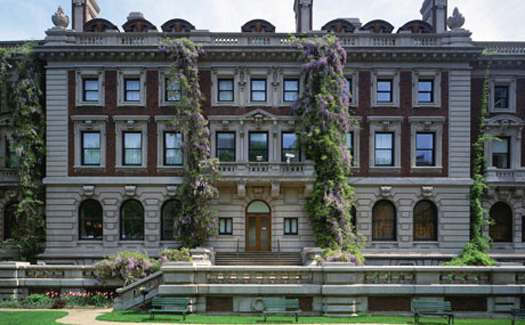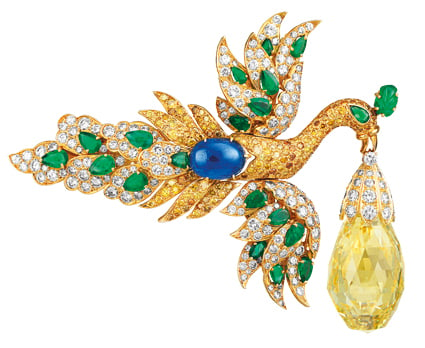
The Cooper-Hewitt's 1902 Carnegie Mansion
This month’s issue of Fast Company, “The United States of Design,” includes a profile of Bill Moggridge, director of the Cooper-Hewitt National Design Museum, co-founder of IDEO, and all around design world untouchable. The profile, by Jessica Lustig (a friend and former colleague), focuses on Moggridge’s big plans for the museum, which variously and vaguely include business partnerships, hands on programs, becoming a clearinghouse for other design organizations, and a better digital presence. What the article can’t, and Moggridge apparently won’t address, is what he’s actually going to do with the museum as a museum. When he lists the museum's constituencies, designers come last.
As Lustig points out, it is probably a plusfor Moggridge that the museum’s mansion will be closed for renovations for the next two years. He has a chance to put programming in the cloud and across the city. But what I hear in this article, and what I’ve been hearing for as long as I’ve lived in New York, is a blame-the-container attitude. It’s the building. It’s the collections. It’s the name. Yes, those things need to be fixed, but I think it is time to call bullshit on the excuses and to ask when the Cooper-Hewitt is going to put on an unmissable exhibit again. Moggridge's ideas about the museum seem to be about everything but the actual products of design. And if that makes me conservative, I suspect I'm not alone.
Here's my laundry list of things the Cooper-Hewitt should do. It would be great if you would add yours too, in comments.
1. Fix the logo. Lustig writes:
Even its own name is an obstacle. In 1994, it was renamed once more as Cooper-Hewitt, National Design Museum, Smithsonian Institution--commas and all. All of its materials use "Cooper-Hewitt, National Design Museum," as well as the Smithsonian's name and sun symbol. "It's a branding issue," says Michael Bierut, graphic designer, partner at Pentagram, and cofounder of the Design Observer website. Moggridge admits he'd like to just make the word "design" really big and shrink everything else.
This is a great idea. It is time for the museum’s many masters to give back by putting the focus on the main event, rather than their stake.
 From "Artist's Designed Wallpapers," Cooper-Hewitt
From "Artist's Designed Wallpapers," Cooper-Hewitt
2. Celebrate the contents. And, isn't this a dumb quote from the AIGA's Richard Grefe?:
"Really, it's a matter of time," he adds, laughing. "How long can people defend a wallpaper collection?"
To the death. Hasn’t Grefe noticed that wallpaper is back? The Cooper-Hewitt’s collections are filled with treasures, and they need to empower their curators to put on exhibitions that connect those treasures to the present day. The Cooper-Hewitt only makes itself generic by pursuing the latest thing. That’s what led to ten years in which no show was without an Apple product. And the increasingly anaemic Triennials.
I enjoyed the one-room guest-curated shows the museum put on (like Kurt Andersen's "Faster, Cheaper, Newer, More"). But I would also enjoy even more professionally curated shows on the great figures of modern design (like my friend Russell Flinchum's 1997 Henry Dreyfuss exhibition) and the hidden persuasions of the things we use (or Ellen Lupton’s 1993 “Mechanical Brides") I can't believe how long ago these shows were, because I still think of them often, and they were formative for my ideas about design and history. Unlike the Museum of Arts and Design (the unmentioned elephant in the room for the C-H, along with MoMA's Architecture and Design Department), the Cooper-Hewitt has collections and a history. Use them.
3. Stop blaming the building.
"I think that the biggest problem they have [at the Cooper-Hewitt] is the building itself, which is a straitjacket rather than a showcase," says Aaron Betsky, director of the Cincinnati Art Museum. "I am afraid that the constraints of the historic building are such that it will be difficult for them to really be the kind of public laboratory for design that I think Bill would like it to be."
Design is not modern art. Most of it isn’t that big. It fits in our houses. Is it really so hard to create an armature that would allow the museum to show different objects in their 1902 Carnegie Mansion? If the best argument for design is that it solves problems, it seems to me there is a solution, and not just the usual hollowing out and opening up. From Fast Company:
The main event of the museum's renovation is the creation of a 6,000-square-foot exhibition space on its third floor for what Moggridge hopes will be "blockbuster" contemporary shows (his curators are still researching possibilities for the first one).
So now they’ll have space, but there’s nothing they are dying to put in it?
It will be interesting to see what attendance is like for the museum’s offsite events. If people still aren’t interested, is it the building at all?
4. Make a Tumblr. An online strategy is key, but I’d like less talk, more pictures. The museum has a blog, and it tweets, and Moggridge holds chats, and it is all very dutiful, but it doesn't have much attitude, and I don't see the online presence generating much interest. Especially while the museum is closed, why not open those same collections up with a Tumblr? Let the curators, interns, administrators, schoolchildren pick objects and post about their history and their enthusiasm. Ask famous design people and business leaders and educators to curate online exhibits. Make it creative rather than dutiful.
5. Challenge the sponsors (constructively). Lustig writes that the museum's No. 1 focus seems to be business. First, the museum should be planning an exhibition about the dawn of the marriage of modern commerce and culture in the 1950s. Second, they should think harder about what they are getting from those business partnerships. Target sponsors the National Design Awards, and has a seat of the board, and has shown itself to be a savvy marketer of design for the masses. (Whether it is "good" or not is another story.)
If the Cooper-Hewitt and Target are really committed to design for all, why not have D.I.Y. events for adults and children at Target stores rather than on the Upper East Side? Collapse the distinction between design museums, their shops, and shopping in a meaningful way, suggesting to consumers simultaneously how they might improve their choices, and think about design as more than a series of consumer choices. In a recent review of the TV show “Quirky,” based on a crowd-sourced design platform of the same name, Washington Post TV critic Hank Stuever wrote:
Meant to celebrate innovation and entrepreneurial can-do spirit, “Quirky” (premiering Tuesday night) instead eerily reflects the vapidity of the American economy and employment picture, where ideas trump labor and success is measured by top-level paydays instead of actual toil. Hipsters invent, while Chinese labor manufactures and shoppers mindlessly buy.
It’s a problem worth thinking about at our design museums too.

From "Set in Style," Cooper-Hewitt
6. Curate smarter. There’s nothing wrong with a jewelry show, done right. “Set in Style,” an exhibition of jewelry by Van Cleef & Arpels was the museum’s last before it closed for renovation, and set an attendance record at 172,000. First, that number is shockingly low. Second, as Karen Rosenberg wrote in the New York Times:
If “Set in Style” didn’t feel so in thrall to the company it might be less of an embarrassment for the museum. The show and its catalog, organized around rubrics like “innovation” and “transformation,” are full of breathless text that reads like ad copy. A short video supplied by Van Cleef & Arpels, showing workers cutting and polishing stones for the company’s signature Mystery Setting, engages in further brand-burnishing.
I’m not a designer per se, but I like shiny things as much as the next person. A clever, historically based show on botanical motifs in jewelry. Or the persistence of color. Or the idea of accessories. Any of these would have captured my attention, particularly if they came with some witty online promotion. Michelle Obama loves her bangles, and she might even have attended a show that seemed less aimed at women who already shop on Fifth Avenue.
"The lesson there, probably," says Moggridge, "is that the forms of design that beautify the human are always popular--so that's jewelry or fashion--and therefore one should make sure one doesn't leave them out."
Moggridge sounds flummoxed by its success, and I fear he has no taste for things. I don't think all the ideas and connections in the world can save a museum with nothing to see.
